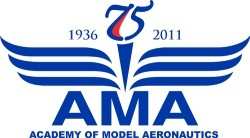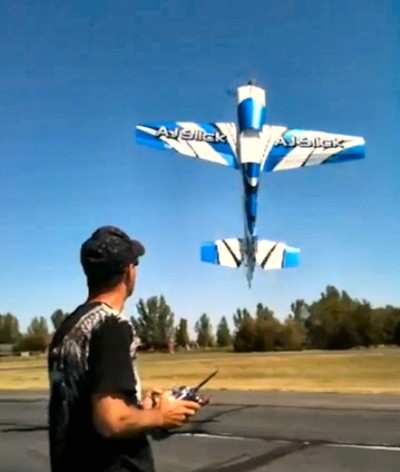Academy Of Model Aeronautics Warns About Heavy Restrictions
Coming From Washington
 The Academy of Model Aeronautics tells ANN that the FAA is set
to place "heavy restrictions" on the hobbyists who fly model
aircraft. In a circular sent to ANN over the weekend, the AMA
indicates that the agency is poised to impose severe restrictions
on the model aviation hobby, sport and industry that will have a
potentially devastating impact on a recreational and educational
activity pursued by hundreds of thousands of enthusiasts, tens of
thousands of employees and an industry that generates more than $1
billion in revenue.
The Academy of Model Aeronautics tells ANN that the FAA is set
to place "heavy restrictions" on the hobbyists who fly model
aircraft. In a circular sent to ANN over the weekend, the AMA
indicates that the agency is poised to impose severe restrictions
on the model aviation hobby, sport and industry that will have a
potentially devastating impact on a recreational and educational
activity pursued by hundreds of thousands of enthusiasts, tens of
thousands of employees and an industry that generates more than $1
billion in revenue.
According to the AMA, the FAA created an Aviation Rulemaking
Committee (ARC) in 2008 tasked with proposing recommendations for
small unmanned aircraft systems (sUAS) that have been
proliferating, particularly those in the commercial realm. The
ARC’s charge was to draft recommended rules relative to
establishing regulations for commercial sUAS and to define model
aircraft – nothing more. AMA’s members are strictly
hobbyists, sportsmen and educators. They are recreational users
that do not participate in commercial activities. AMA was assured
that the recreational modeler would be exempted from
regulation.
 In 2008, the ARC began its work with 20 members, more than
half of which were from the commercial and public sectors with
partisan interests. AMA was the lone seat for the hobbyist.
AMA’s says its views and concerns were quickly swept aside in
the haste to create enabling regulation for the commercial/public
use sUAS industry. Subsequent protests and historical data
presented by AMA have been repeatedly dismissed.
In 2008, the ARC began its work with 20 members, more than
half of which were from the commercial and public sectors with
partisan interests. AMA was the lone seat for the hobbyist.
AMA’s says its views and concerns were quickly swept aside in
the haste to create enabling regulation for the commercial/public
use sUAS industry. Subsequent protests and historical data
presented by AMA have been repeatedly dismissed.
In March 2009, the ARC submitted its report to the FAA
recommending a two-path approach for model aviation. This two-path
approach proposes a “default path” that contains a
devastating set of heavy-handed regulations and restrictions that
will have a detrimental impact on the industry and thousands of
aeromodeling enthusiasts not involved in AMA’s membership or
programming. Alternatively, AMA must develop and fund an acceptable
set of standards in order to overcome the restrictive effects of
the default regulations. The two-path approach is extremely
problematic and will adversely affect the aeromodeling community.
AMA voiced strong opposition to this approach in the ARC’s
report to the FAA.
AMA says that over the past 18 months it has worked diligently
in an attempt to develop an acceptable set of standards to address
FAA concerns. At the same time, however, the ground rules continue
to change, creating a moving target and mounting frustration.
AMA believes that the proposed regulations fail to address the
substantial diversity of the hobby and its applications and
establishes unenforceable restrictions, while leaving absent a
safety surveillance program to support the thousands of modelers
outside of AMA’s formal structure and standards.

Large Model Aircraft
Although the exact language of the proposed regulation is not
yet known, there are a number of conclusions that can be drawn from
the ARC recommendations. The following are AMA’s areas of
concern, the restrictions that are likely to be imposed and their
effect on the model aviation community:
- ALTITUDE: As proposed, the rule would impose a nationwide
altitude ceiling of 400 feet. AMA recognizes the need for altitude
limitations when model aircraft are operated in close proximity to
airports, and this concept is supported in AMA’s current
Safety Code. However, a nationwide altitude ceiling for model
aircraft is impractical, unnecessary, unrealistic and unenforceable
through any reasonable means of compliance and detection.
- SPEED: It is likely that the rule will attempt to limit model
aircraft performance by establishing a set speed limit such as 100
mph. Imposing such a speed limit will have little to no effect on
aircraft performance and is both undetectable and unenforceable
through any practical, cost-effective means.
- WEIGHT: As proposed, the sUAS rule will limit small unmanned
aircraft to 55 pounds or less, and the implication for AMA’s
Large Model Aircraft Program has not yet been determined. Without
an acceptable standard or an alternative means of compliance, this
rule may well curtail a vital element of the modeling activity that
drives creativity, innovation and technological development.
- TURBINE BAN: The blanket prohibition of gas turbine engines
suggested in the ARC recommendations does not consider the wide
range of products currently in the marketplace. The inclusion of
this prohibition in the proposed rule will impose a significant and
unjustified economic impact on the industry.
- AIRPORT PROXIMITY: It is understood that the FAA is considering
going outside the ARC’s recommendation and extending the
“area of concern” around the nation’s 19,760
airports beyond the current 3-mile radius that has been the
standard for more than 29 years. The intent to extend this radius
has absolutely no statistical basis, has no supporting data and has
no accident or incident correlation. Doing so would exponentially
impact the number of existing flying sites affected by the rule.
Extending the radius by as little as 2 miles (to 5 miles) would
nearly triple the area of concern and create more than 1,784,000
square miles in which “no fly without permission”
restrictions would be imposed.
It is the position of the AMA that, based upon the direction the
rule is headed, it is clearly evident that the intent is not to
objectively evaluate the model aircraft operations and
realistically assess the risks. It is rather to unfairly eliminate
model aviation from the safety equation by arbitrarily eliminating
it from the airspace it has revered and safely used for decades.
The organization urges all who are in favor of full analysis,
regulatory restraint and fair play to help AMA save a hobby, a
dynamic sport, a vital educational pursuit, and a $1 billion
industry from what it says is undue government intervention
that will have devastating consequences.
 ANN's Daily Aero-Linx (04.16.24)
ANN's Daily Aero-Linx (04.16.24) Aero-News: Quote of the Day (04.16.24)
Aero-News: Quote of the Day (04.16.24) Airborne 04.10.24: SnF24!, A50 Heritage Reveal, HeliCycle!, Montaer MC-01
Airborne 04.10.24: SnF24!, A50 Heritage Reveal, HeliCycle!, Montaer MC-01 Airborne 04.12.24: SnF24!, G100UL Is Here, Holy Micro, Plane Tags
Airborne 04.12.24: SnF24!, G100UL Is Here, Holy Micro, Plane Tags Airborne-Flight Training 04.17.24: Feds Need Controllers, Spirit Delay, Redbird
Airborne-Flight Training 04.17.24: Feds Need Controllers, Spirit Delay, Redbird





